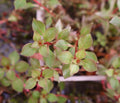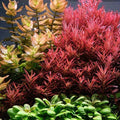Why Do Aquarium Plants Melt? (Part 1)
Exactly why do aquarium plants melt?
If you're unfamiliar with the aquarium industry, the idea of tank plants melting could seem strange. In reality, it's just a fancy name for a plant that's about to go extinct.
As we'll see in a moment, there are a number of reasons, but ignorance on the part of the aquarist is the main problem.
The phrase should not be interpreted negatively but rather as stating a reality. Aquatic plants are often seen by beginning aquarists as ornamental features or inferior aquatic additions.
As a result, they provide the fish with the best care possible but neglect to give the plants the same. As you'll see in a moment, this has potentially disastrous effects on both plants and fish.
What Causes the Melting of Aquarium Plants?
Look for a reason right away if you discover that your aquarium plants are starting to die.
Dying plants will have a negative impact on the water's chemistry as well as the tank's appearance and your plant investment.
Plants produce organic debris, which, when it decomposes in the water, provides the ideal environment for ammonia accumulation.
Aquarium plants often begin to deteriorate for a number of reasons, including:
Lack of Nutrition
In aquariums that are overstocked, this is a regular issue. A range of nutrients, vitamins, and minerals are often present in aquatic environments and will feed both plants and fish.
However, there may sometimes be imbalances, and overstocking is a significant contributor. When there are too many fish and plants together, the water's nutrients are quickly depleted, starving the plants.
If not treated correctly and promptly, nutrient deficiencies may be fatal. You must correctly identify them before you can do it.
Here are several indicators to think about:
Iron deficiency
The plant will have discolored leaves that might be entirely white, pale green, or yellow. This is due to the fact that iron, in addition to being created for a number of enzymes, is a crucial component in the formation of chlorophyll. Fortunately, the plant will gradually change color, giving you time to intervene and resolve the issue. The problem will be quickly resolved if you use a tank iron supplement made for plants.
Calcium deficit
When utilizing soft water during water changes, calcium shortages often happen. Since RO water contains extremely few minerals and other nutrients, it is obvious that it is to blame for this. Therefore, supplementation is required prior to carrying out the water change.
The primary symptoms of calcium insufficiency are brittle plants and withered, twisted leaves. This is because calcium affects the stability and hardness of the plant's cells. Either a calcium supplement or just using crushed coral to adorn the tank are viable solutions. The calcium will gradually dissolve into the water, preserving the health and longevity of the plants.
Potassium Deficiency
Potassium is a particularly significant nutrient since it serves as a transporter for other nutrients as they move through the plant's system. The damaged plant will have curled edges and small holes in its leaves. Additionally, they could seem paler than their normal, healthy hue. It takes a potassium supplement to get the nutritional levels back to where they should be.
Manganese Deficit
Manganese is a mineral that is essential to the process of photosynthesis, without which a plant cannot survive. Around the margins of the leaves, the damaged plant(s) will have light yellow or white patches. Manganese insufficiency is lethal if left untreated. To solve the issue, take into account employing a supplement.
Lacks of magnesium, phosphorus, nitrogen, and other nutrients, among others, will also change how the plants work. The key is to understand the different types of nutritional shortages and use the right approach to solve the problem.
Absence of Light
In essence, photosynthesis is necessary for plant survival. It's easy to do, but difficult to describe.
In plain English, the plant will transform the solar energy into chemical energy, some of which will be stored as sugars and starches, and some of which will be turned into oxygen.
The plant will essentially discard the oxygen into the environment as a byproduct.
Because they oxygenate the environment, whether it be aquatic or atmospheric, plants are crucial.
The issue is that plants manufacture CO2 instead of using oxygen to thrive when there isn't any sunshine.
The plant will essentially starve if the lights are off for a long enough period of time, since photosynthesis would be impossible.
For plants to have the best chance of thriving, I advise utilizing LED lights for around 8 to 10 hours each day.
The time is here for me to warn about the risks of poor light balance. The plant will be harmed by too little light, but an abundance of it will encourage the development of algae.
Finding the sweet spot is the goal; it usually lies around 1 watt per gallon.
However, as not all tank plants need the same level of lighting intensity, feel free to experiment with the wattage.
Ecological Change
This issue often arises when fresh plants are introduced to the area. The fact that the plant hasn't had enough time to become used to its new environment is the true problem here.
Numerous problems will result from this, most of them connected to nutritional consumption.
Since the plant's roots have never lived in a place where they are completely submerged, they must first get used to being in water.
Because of this, the roots are not used to such high levels of humidity, which might affect a plant's capacity to absorb nutrients from its surroundings. The tank plant will adapt; the good news is that it simply requires some time.
Therefore, you should only immerse the plant's roots; for a few days, keep the leaves above water. The plant may often lose a few leaves and display some pain, but it will ultimately recover.
If the plant was already completely submerged when you bought it, you might not need to do this step.
















